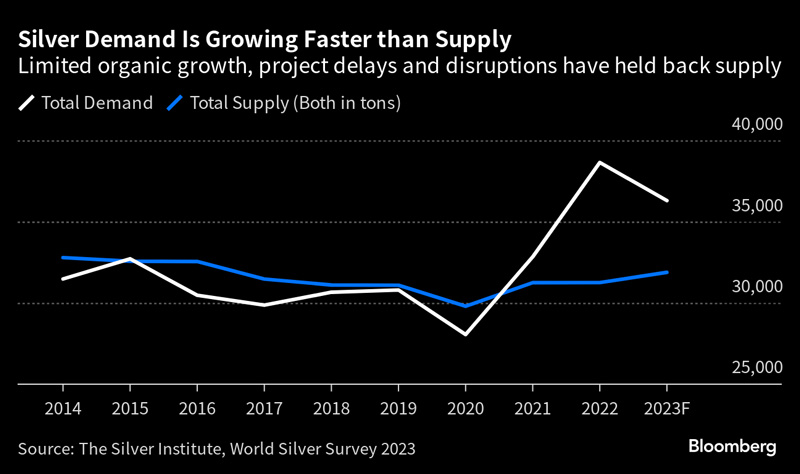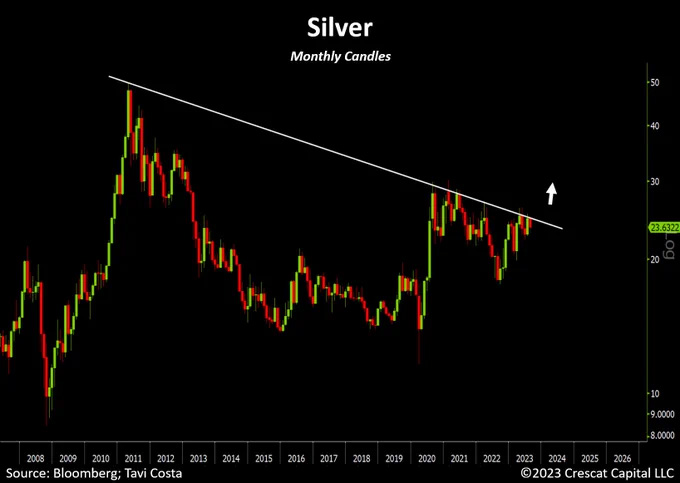Why Silver Is One Of The Most Important Elements On Earth
Mike Maloney
 This month, we’re shining a spotlight on silver. Did you know that in over 14 languages, the word for "silver" is synonymous with "money"? That's no coincidence... This month, we’re shining a spotlight on silver. Did you know that in over 14 languages, the word for "silver" is synonymous with "money"? That's no coincidence...
It’s far more than your ordinary metal, silver is a versatile marvel that has fascinated humanity and been used as money for thousands of years.
If you're new to the precious metals game or even a seasoned investor, here’s some of the reasons why silver should belong in your portfolio.
Silver Is The World’s Most Reflective Metal— Polished silver reflects 95% of the visible light spectrum, which makes it the most reflective metal known to man. Its reflective properties are also used for objects like mirrors, telescopes, microscopes and solar panels.
Silver Has The Highest Thermal Conductivity Of Any Element — Out of all the elements, silver is the best electric conductor, and is actually used as the standard by which other conductors are measured. On a scale of 0 to 100, silver ranks 100 in terms of electrical conductivity. Meanwhile copper ranks 97 and gold ranks 76.
Silver Is One Of The First Five Metals To Ever Be Discovered — Silver artifacts have been found dating as far back as 4000 B.C. Silver was the first metal to be used as currency, and in ancient Egypt, it was even valued higher than gold.
Stretching The Limits: Thin As Paper, Yet Unbreakable — Silver is an incredibly ductile element, capable of being shaped, compressed, and stretched while maintaining its structural integrity. For example, a single grain of silver can be pressed into a plate 150 times thinner than a typical sheet of paper.
In 1965, Public Law 88-36 Reduced Silver In Coins From 90% To 40%— Silver was eliminated from all coins in the United States beginning in 1970. As a result, silver coins containing 90% are valuable based on their silver content and are extremely desirable to collectors and investors.
Silver Is More Than Just Money
Many people are familiar with silver’s history as an investment – but unfortunately its numerous industrial applications are often overshadowed. The truth is nearly 50% of the annual silver supply is used in industrial applications and manufacturing. And that silver is truly indispensable in modern society.
Electronics: Silver’s Invisible Everyday Presence
You may not see it, but silver is used in virtually every single one of your electronic devices. If you're interacting with a gadget that has an on/off button, it's highly likely that silver is a key component.
Known for its unparalleled electrical conductivity, silver is the perfect material for a wide array of applications. It's found in everything from printed circuit boards and switches to TV screens, telephones, microwave ovens, children's toys, and even the keys beneath our computer fingertips.
As of 2023, there are over 15 billion devices connected to the internet worldwide – and that figure is expected to double by 2030. As we further embrace the digital age, the demand for silver in these sectors is poised to rise.
Renewable Energy: Silver’s Role In Powering A Sustainable Future

In the pursuit of sustainability, silver has been proven to be a vital component, particularly in the photovoltaic cells that make up solar panels.
So, how exactly does silver function in solar cells? Silver powder is converted into a paste, which is then applied to a silicon wafer. When sunlight strikes this silicon, electrons are set free. Silver, being the world's most efficient conductor, swiftly channels this electricity either for immediate utilization or for storage in batteries for future use.
As many nations around the world increase their clean energy investment, the demand for silver is set to rise in tandem, further solidifying its critical role in our sustainable future.
Silver's Healing Power: From Ancient Voyages To Modern Medicine

Long before the scientific community understood silver's antibacterial properties, the metal was already being used to combat harmful germs. During lengthy ocean voyages, sailors would drop silver coins into water and wine casks to keep them from spoiling. For years, physicians applied drops of silver nitrate into the eyes of newborns to stave off infections. Even in the grim conditions of World War I, silver foil dressed battlefield wounds, and silver sutures were used to stitch up severe injuries.
It is only in recent years that scientists have unraveled the mechanisms behind silver's antibacterial effects. Silver ions have the unique ability to penetrate bacterial cell walls without harming mammalian cells. This disrupts the essential chemical and structural bonds within the bacteria, effectively neutralizing them.
Today, the medical community is leveraging silver's unique properties in innovative ways. Medical devices like breathing tubes and catheters are now coated with silver to ward off infections. The metal is also applied to artificial bones and scaffolding materials to aid in the healing process. Silver-infused bandages and ointments are increasingly common, as they inhibit bacterial growth, allowing wounds to heal more quickly. Remarkably, silver has proven effective against bacteria that have developed resistance due to the overuse of chemical antibiotics.
The Electric Vehicle Boom Is Driving Up Silver Demand

From 2021 to 2022, the number of electric cars sold almost doubled, breaking records, and increasing from 3.75 million to 6.75 million globally.
Electric cars depend heavily on silver. Much like many other devices these days, the electrical and thermal conductivity of silver makes it an ideal material as part of an automobile battery. It is also ideal for use in EVs because it’s non-toxic and hypoallergenic.
As it stands, the automotive industry consumes a staggering 55 million ounces of silver each year. By 2025, this figure is projected to leap to 90 million ounces.
So, where is all this silver coming from? If these electric vehicle companies all want to continue their rapid growth, it will require a huge increase in silver production.
However, there's a snag: the demand for silver is currently outpacing its supply, creating a looming bottleneck for the industry.
Silver Supply Constraints And A Looming Crisis
According to the World Silver Survey 2023, the global appetite for silver surged by 18% last year, reaching a record-breaking 1.24 billion ounces and resulting in a significant supply deficit.
In 2021, the silver market faced a shortfall of 51.1 million ounces. However, the situation deteriorated dramatically in 2022, with a staggering undersupply of 237.7 million ounces. The Silver Institute has labeled this as "possibly the most significant deficit on record," and forecasts indicate that the shortages are likely to continue in the years ahead.

The reasons for this tightening supply are multifaceted:
Rising Operational Costs: The mining sector is wrestling with escalating expenses, particularly in energy and labor.
Environmental Regulations: An influx of stringent environmental laws is adding layers of complexity to the mining process.
Mexico's Policy Shift: In a significant setback, Mexico, the world's leading silver producer, has instituted a ban on open-pit silver mining.
With global sustainable investments reaching an astonishing $35.3 trillion, as reported by the Global Sustainable Investment Alliance, the demand for silver — integral in many green technologies — is poised to skyrocket.
For many investors, alarm bells are ringing. When record high demand meets a tightening supply, at some point, something has to give. Either the supply of silver somehow increases a great deal, or the price of silver will increase.
Given these market conditions, the logical outcome could be a surge in silver prices in the years ahead.
Many analysts like Tavi Costa, renowned portfolio manager at Crescat Capital, agree that silver prices are going higher.
He says, “Going back to 2011, you can see the monthly chart, the resistance has lessened for over a decade now. And we’re very, very close to a breakout with this chart. This could happen any month really.”

Seizing The Silver Opportunity
The evidence is clear: silver is not just a precious metal – it's a critical component in modern technology, renewable energy, and healthcare. With supply constraints and rising demand, the future for silver looks incredibly promising.
If you've been contemplating diversifying your portfolio, there's never been a better time to get started investing in silver today.

Michael Maloney is host of the smash-hit video series Hidden Secrets of Money, author of the bestselling precious metals book Guide to Investing in Gold and Silver, and founder of GoldSilver.com, one of the world's most highly regarded investment education companies and a global leader in gold and silver sales. For more than a decade, he’s traveled the world sharing his relentless passion for economics and monetary history with audiences from Silicon Valley to Wall Street, from Hong Kong to Rome.
As he delved into financial markets, monetary history, and global economics, Mike discovered that the same economic cycles kept repeating over and over throughout history, from ancient times to modern day. "For 2,400 years as people have lost faith in fiat currencies, they have turned to 'real money,' gold and silver," Mike says. "Today the stage is set for a worldwide 'gold rush' to the safe haven of precious metals just when supplies of those metals are precariously low. The opportunity for those who position themselves accordingly, ahead of the crowd, is like none we will see again in our lifetimes.
goldsilver.com
| 

